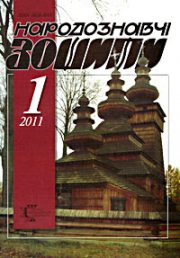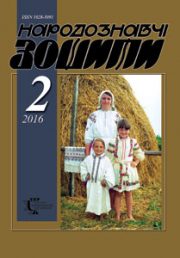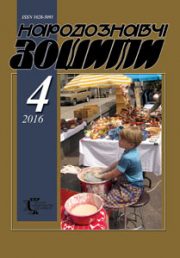The Ethnology Notebooks. 2021. # 2 (158), P. 389—394
УДК 394.2 (447+438)
DOI https://doi.org/10.15407/nz2021.02.389
Tamara PATSAY
- ORCID ID: https://orcid.org/0000-0002-4469-250X
- Candidate of Historical Sciences,
- Scientific Secretary
- of the Ethnology Institute
- of National Academy of Sciences of Ukraine,
- 15, Svobody Avenue, 79000, Lviv, Ukraine,
- e-mail: patsay@nas.gov.ua;
Oksana SHEREMETA
- ORCID ID: https://orcid.org 0000-0002-9716-4938
- Candidate of Historical Sciences,
- State University of Communications,
- Associate Professor of Documentation
- and Information Activity,
- 7, Solomyanska Street, 03110, Kyiv, Ukraine,
- e-mail: sheremeta.oksana14@gmail.com
Problem statement. Adam Fischer is a prominent figure in the Polish Ethnographic Society (PTL), a well-known ethnographer, folklorist, philologist, literary critic, educator and public figure. A. Fischer, a researcher of the Ukrainian and Polish ethnic groups, was one of the most prominent ethnographers of the 1920s and 1930s. and left behind a large number of still relevant scientific papers. As with many other scholars of the time, part of his scientific legacy is scattered in the pages of periodicals and published under pseudonyms or cryptonyms. The article is devoted to the analysis of early publications on ethnographic topics by A. Fischer, which were published by scientists in the Catholic weekly Kronika Powszechna in 1912—1914.
Based on the analysis of A. Fischer’s works, the main results of his articles, which concerned to the brightest folk traditions and rites were highlighted: Christmas and Easter holidays, folk Easter painting, spring folk customs. Emphasis is placed on the analysis of the dynamics of Polish folk customs, as well as the author’s view of individual folk traditions is considered in view of the prospects of their transformations and existence in the future.
The presented material proves the position of the scientist on the need to preserve folk monuments and consolidate folk customs. Since the first ethnographic publications, the scientist shows his own interest in certain ethnographic areas, which he will address in the coming decades in his works, collections, textbooks and encyclopedias.
The research methodology is based on theoretical analysis, systematization and generalization, historical examination and observation of the author.
Keywords: Adam Fischer, folk performances, Easter eggs, Kronika Powszechna.
REFERENCES
- Bar, A. (1938). Dictionary of pseudonyms and codenames of Polish and Polish writers concerning (Vol. III). Krakow [in Polish].
- Kyrchiv, R.F. (2013). Studies on the Ukrainian-Polish ethnocultural frontier. Lviv: Ivan Franko National University of Lviv [in Ukrainian].
- Tarnavskyj, R. (2013). In memory of Adam Fisher. Biography of a professor of ethnology at Lviv University. Folk art and ethnology, 5, 40—53. Kyiv[in Ukrainian].
- Simonides, D. (1997). From the history of Polish folklore. Adam Fischer’s place. Scientific journals of the University of Opole. Folklore (Vol. 3, pp. 25—44). Opole [in Polish].
- Jasiewicz, Z., & Rieszetow, A.M. (2003). Correspondence between Adam Fischer and Dymitri Konstantynowicz Zielenin. Polish ethnography (Vol. 47, pp. 31—47). Warszawa [in Polish].
- Klodnicki,Z. (Ed.). (1997). Chronicle of the Polish Ethnological Society (1895—1995). Wroclaw [in Polish].
- Golovatyuk, V.D. (2012). Adam Fisher: scientific achievements and organizational activities. Slovyans’kyi svit (Vol. 10, pp. 19—30). Kyiv [in Ukrainian].
- Armon, K. (2007). Adam Robert Fischer. Polish ethnographers and scholars. Silhouettes, biographical sketches (Vol. II, pp. 77—83). Wroclaw; Krakow [in Polish].
- Zawisza, W. (1912). Polish nativity scene. The Universal Chronicle. A social, literary and scientific weekly, 52, 443—444.Lviv[in Polish].
- Fischer, A. (1916). Polish folk shows. Lviv [in Polish]
- Zawisza, W. (1913). Holy Old Polish. The Universal Chronicle. A social, literary and scientific weekly, 12, 204—205. Lviv [in Polish].
- Fischer, A. (1913). Easter eggs. The Universal Chronicle. A social, literary and scientific weekly, 12, 7—8. Lviv [in Polish].
- Fischer, A. (1914). People and spring. The Universal Chronicle. A social, literary and scientific weekly, 15, 57—88. Lviv [in Polish].
- Fischer, A. (1914). Oskar Kolberg. The Universal Chronicle. A social, literary and scientific weekly. 4—5, 33—36. Lviv [in Polish].
- Fischer, A. (1913). To Wawel! The Universal Chronicle. A social, literary and scientific weekly, 4, 59. Lviv [in Polish].






